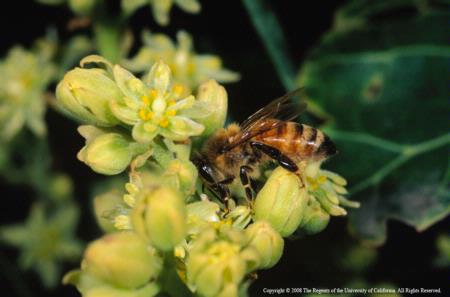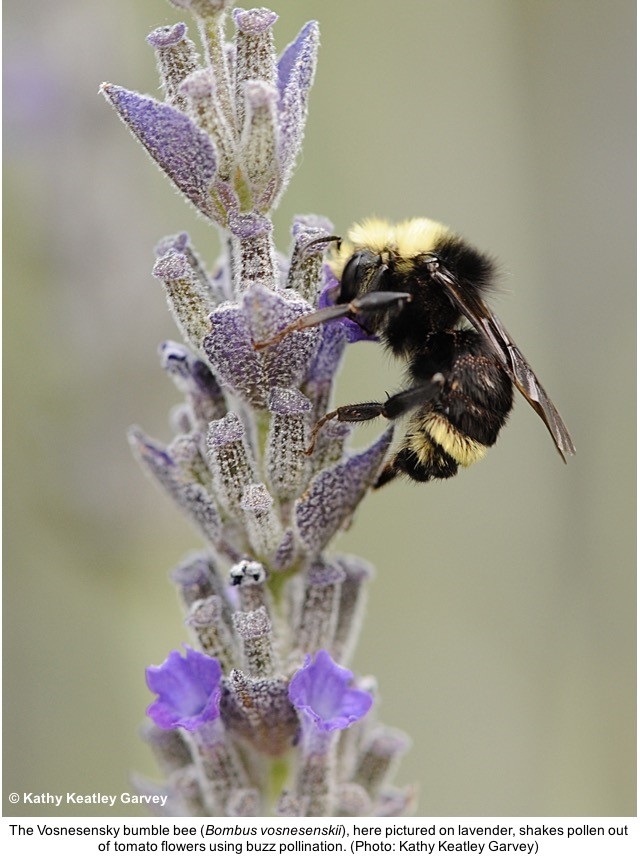
Posts Tagged: native pollinators
Bumble Buzzing Pollen Gathering
Imagine going to the supermarket to stock up on groceries but coming home empty-handed because you just couldn't figure out how to work the shopping cart or figure out how to get to the ice cream tubs in the freezer aisle.
Welcome to the life of a bumblebee.
Gathering sweet nectar from flowers, it turns out, is much more difficult than one might think, and it requires a lengthy learning process. By the time a bee has figured out how to efficiently pry open the lips of a snapdragon flower, for example, most likely it has made dozens, if not hundreds, of floral visits.
How does a bee in charge of shopping for food needed to raise dozens of hungry larvae back in the hive learn to navigate the multitude of floral architectures it may encounter during an average workday, let alone over the course of its life?
Mostly by what biologists call associative learning, more widely known as trial and error, researchers have found. But while extensive research -- starting with famous bee researcher and Nobel laureate Karl von Frisch a century ago -- has focused on uncovering how bees forage for nectar, much less is known about how bees go about collecting pollen, which constitutes the most important protein source for the developing brood in the hive.
Avery Russell, Stephen Buchman and Daniel Papaj in the Department of Ecology and Evolutionary Biology at the University of Arizona decided to take a closer look. In a new paper published in the journal Behavioral Ecology, they tell a fascinating story of what is involved in a seemingly simple process of a bumblebee visiting a flower to gather pollen. And for the first time, they have untangled the subtle cues that a bee looks for when she visits a flower in search for pollen.
"For a long time, we have known that bees can learn all kinds of cues -- tactile, visual and olfactory -- when going after nectar rewards," says Russell, the study's first author. "When you open a can, you have to use a can opener, then use your fingers to pry the lid open. A bee might have to pop open the flower's petals, and might have to try many times over multiple trips until they get good at it. But not much was known in the context of pollen rewards."
Specifically, Russell and his co-authors wanted to know if bees need to learn in order to collect pollen efficiently from flowers that vary in their form. The research suggests they don't, and they don't need to.
"Our findings suggest that unlike nectar foraging, which requires complex learning behavior, bumblebees already know how to collect pollen," says Russell, who did the research as a doctoral student in the UA's Graduate Interdisciplinary Program in Entomology and Insect Science, "and they do it by switching between two responses that are seemingly hardwired into their brains."
Once a bumblebee touches down on a flower, it wastes no time. If it senses that the anthers are laden with abundant pollen just waiting to be shaken off like ripened apples from a tree, the bee does the obvious: a behavior that bee researchers call "scrabbling." Using its mandibles and legs, the bee brushes the pollen grains onto its body, then combs them off into collection baskets located on each of its hind legs.
"If you picture a happy toddler in a play pit filled with plastic balls, you get the idea of scrabbling," Russell says.
However, some flowers make their pollen grains more difficult to access, or sport intricate anther designs that dispense only a little bit of pollen at a time.
"That way, the plant makes sure pollinators don't eat it all, but carry it to other flowers for pollination instead, and also leave some for other visitors as well, so the flowers aren't limited to a single pollinator," he says.
When visiting some of these trickier flowers, Russell's team found, bumblebees switch to a different behavior called sonication -- or, in more familiar terms, buzzing. Not unlike a sonicating toothbrush that vibrates to shake plaque from teeth, a sonicating bee vibrates vigorously to free pollen grains hidden inside the flower.
The team observed that the bees switched between these two motor regimes depending on chemical and mechanical cues: They scrabbled when pollen was abundant, and sonicated when pollen was scarce, either because the flower already had been depleted or because its pollen is less accessible by design.
To tease apart the cues that trigger each behavior, the researchers made artificial flowers and treated some of them with chemical extracts from natural anthers. Bees visiting a surrogate flower without extract didn't stick around and took off again in search of more rewarding offerings. When they encountered a foam flower without pollen but with the chemical cue, they buzzed them in a futile attempt to harvest the nonexistent pollen. And when they sensed pollen grains, even artificial ones, scrabbling ensued.
"Bumblebees tend to sonicate on pollen-concealing anthers right away, but they also buzz accessible anthers when they can't detect pollen by touch," Russell says. "We think they do that in an effort to collect the dregs from a flower after most of its pollen has been harvested."
Being able to switch between two programmed routines allows bees to effectively collect pollen from flowers in many different shapes and forms, the researchers conclude. This flexibility also may explain a fact that had evolutionary biologists stumped for a long time: Flowers with concealed pollen stores evolved many times independently, suggesting that pollinators must always have had a way to harvest pollen from them, or else the co-evolution between the two would have led to a dead end and not survived.
"Researchers used to think that floral sonication is a behavior only used to collect pollen from concealed pollen stores," Russell says, "but because we often observe bees buzzing on flowers with accessible pollen, we conclude that it's a behavior that has evolved as a general strategy to collect pollen from any type of flower."
To buzz or to scrabble? To foraging bees, that's the question
Presenting bumblebees with various combinations of natural and artificial flowers laced with chemical and mechanical cues, UA biologists have discovered that for a bumblebee, foraging for pollen versus nectar is very different.
photo: honeybee on avocado flower. Is it buzzing or scrabbling?

bee avocado flower
Beeezzz Weeeeeek
Pollinator Week, June 19–25, 2017: Bee Knowledgeable!
UC Statewide IPM Program
Remember, the plant that contributes the pollen is the pollenizer (sometimes pollinzer or polleniser) and the animal that moves the pollen is the pollinator (sometimes pollenator) which doesn'talways have to be a bee, but can be another insect, bat, bird or butterfly or ....
Bees are the most important pollinators of California agriculture—helping us grow field crops, fruits, nuts, and vegetables. Honey bees receive most of the credit for crop pollination, but many other kinds of bees play an important role as well. There are 1600 species of bees in California! Take time during Pollinator Week to learn about the different kinds of bees and what you can do to help them flourish.
Why should I care about other kinds of bees?
Bees other than honey bees contribute significantly to crop pollination. For example, alfalfa pollination by alfalfa leafcutter bees is worth $7 billion per year in the United States. Other bees can also boost the result of honey bee pollination—in almond orchards, honey bees are more effective when orchard mason bees are present. The more bee species, the merrier the harvest!
While growers often rent honey bee colonies to pollinate their crops, some wild bees pollinate certain crops even better than honey bees do. For instance, bumble bees are more effective pollinators of tomato because they do something honey bees do not: they shake pollen out of flowers with a technique known as buzz pollination. Likewise, native squash bees are better pollinators of cucurbits—unlike honey bees, they start work earlier in the day, and males even sleep in flowers overnight.
How can I help honey bees and other bees?
When it comes to land management and pest management practices, some bees need more accommodations than others. That's why it is important to know what bees are present in your area and important to your crop, and plan for their needs. Use this bee monitoring guide from the University of California to identify the bees present on your farm.
You can help all kinds of bees by using integrated pest management (IPM). This means using nonchemical pest management methods (cultural, mechanical and biological control), monitoring for pests to determine whether a pesticide is needed, and choosing pesticides that are less toxic to bees whenever possible. Check out the UC IPM Bee Precaution Pesticide Ratings to learn about the risks different pesticides pose to honey bees and other bees, and follow the Best Management Practices To Protect Bees From Pesticides.
Bees also need plenty of food to stay healthy and abundant. Plant flowers that provide nectar and pollen throughout the year. See the planting resources below to find out which plants provide year-round food for specific types of bees.
Like honey bees, native bees need nesting areas to thrive. Bumble bees, squash bees, and other bees nest underground. Ground-nesting bees may require modified tilling practices (such as tilling fields no more than 6 inches deep for squash bees) or no-till management to survive. For aboveground nesters like carpenter bees and mason bees, consider planting hedgerows or placing tunnel-filled wooden blocks around the field. See the habitat resources below for more information about native bee nesting in agricultural areas.
Enjoy your “beesearch!”
Bee Habitat Resources
- Habitat for Bees and Beneficials
- Managing Wild Bees for Crop Pollination
- Native Bee Nest Locations in Agricultural Landscapes
- Farming for Bees: Guidelines for Providing Native Bee Habitat on Farms
- Hedgerow Planting for Pollinators: Central Valley, Central Coast, Southern California
- Conservation Cover for Pollinators: Central Valley, Central Coast, Southern California
- The Integrated Crop Pollination Project: Tools for Growers
Sources
- Insect Pollinated Crops, Insect Pollinators and U.S. Agriculture: Trend Analysis of Aggregate Data for the Period 1992–2009.
- Native bees are a rich natural resource in urban California gardens. (PDF)
- Honey bees are more effective at pollinating almonds when other species of bees are present.
- http://cagardenweb.ucanr.edu/General/Encouraging_Native_Bees_-_Other_Pollinators/
- How to Attract and Maintain Pollinators in Your Garden - https://anrcatalog.ucanr.edu/pdf/8498.pdf
Bombus vosnesenskii ( say that fast) a CA native bumble bee buz pollinating a lavendar (not CA native) flower (photo: Kathy Keatley Garvey)

bombus vosnesenskii

bumblebee
Native Pollinators of Avocado
Dr. Gordon Frankie at UC Berkeley is teaming with me in Ventura County to jointly work on a pollination study for avocados. Dr. Frankie is studying how to increase native bee pollinators in avocado orchards. To do this, we plan on surveying the native bees that are in the area, identify the plants that they are foraging on and then plant those species in orchards to lure indigenous bees + pollinators in to the orchards. These plants will also be monitored for their attractiveness to beneficial insects which could control avocado thrips, persea mite along with other pests. We have applied for UC grants and will apply to CA Avocado Commission and CDFA Specialty Crops for money. We plan on planting the natives before the winter rains, if they ever come.
For a review of the native pollinators, check out the UC publication: How to attract and maintain pollinators in your garden. http://anrcatalog.ucdavis.edu/pdf/8498.pdf
X

bumblebee
